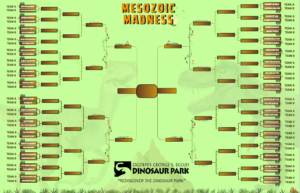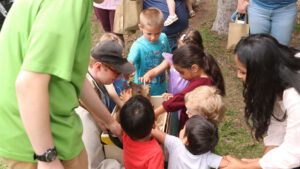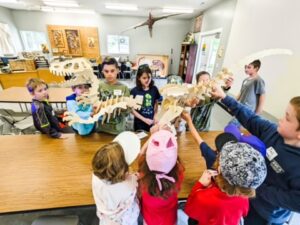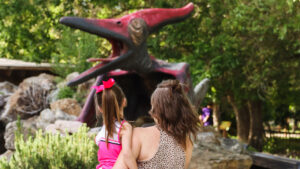DISCOVER THE MYSTERY OF PRE-HISTORIC LIFE
WHERE HISTORY COMES ALIVE
The Dinosaur Park is an exciting collection of creatures from prehistoric crawlers, to predators and even flying reptiles.
STEWART MUSEUM OF PALEONTOLOGY
PALEONTOLOGY LAB
The Stewart Museum of Paleontology is designed to take you on a journey through time, starting from the earliest forms of life on Earth and ending with the present day. You will see incredible displays of dinosaur skeletons, reconstructed habitats of prehistoric animals, and interactive exhibits that allow you to experience what life was like millions of years ago.
OUTDOOR SCULPTURE PARK
COLLECTION OF PREHISTORIC-INSPIRED ART
Our outdoor sculpture park is a unique attraction that offers visitors a chance to view a collection of beautiful sculptures inspired by dinosaurs, prehistoric creatures, and the natural world. The park is located within the Dinosaur Park and provides a perfect opportunity for visitors to learn more about prehistoric life and the beauty of art.
OGDEN NATURAL HISTORY MUSEUM
EXPLORE THE NATURAL WORLD THROUGH INTERACTIVE EXHIBITS
GEM AND MINERAL MUSEUM
DISCOVER THE BEAUTY AND SCIENCE OF MINERALS AND GEMSTONES
SUMMER CAMPS
Roar into FUN this summer at the Dinosaur Park!
We have exciting Preschool and Elementary-aged summer camps. Register Now before they are sold out!
WHAT’S HAPPENING AT THE DINOSAUR PARK
*Strollers/Wagons must be parked for the museum indoors portion of the event. You may skip the Museum to avoid parking your strollers or wagons.

Mesozoic Madness
Get ready for a March Madness like no other! Introducing the ultimate showdown: Dinosaur Bracket Challenge! From fierce T. rex to cunning Velociraptor, which dino will reign supreme in our

2024 Preschool Camps
These special events provide a safe and comfortable environment for individuals and families who may find traditional museum settings overwhelming.

2024 Elementary Camps
These special events provide a safe and comfortable environment for individuals and families who may find traditional museum settings overwhelming.

Dino Lift Tickets
Celebrate the SNOW with us by bringing in your 2023/2024 ski pass and receive 50% off admission!

Wee Wednesday
Every Wednesday from 10AM-12PM parents enjoy a morning of discovery with toddlers and preschoolers, full of story time and play!

Sensory Friendly Nights
These special events provide a safe and comfortable environment for individuals and families who may find traditional museum settings overwhelming.
Discover the wonders of prehistoric life at Ogden Dinosaur Park, a premier destination for natural history enthusiasts. Immerse yourself in a world where dinosaurs roam, exploring life-sized exhibits, interactive displays, and fossil digs. Perfect for families and scholars alike, the park offers a unique blend of education and entertainment, bringing ancient history to life. Experience the thrill of the past at Ogden Dinosaur Park and embark on an unforgettable journey through natural history.
THE MOST MEMORABLE ADVENTURE FOR THE WHOLE FAMILY!
The Dinosaur Park offers birthday party packages, each coming with general all day admission to the Museum and Park. Packages range from a general admission party to the raging deluxe birthday party package.
GROUP EVENTS
Memberships are good for 1 year from the date of the purchase. Memberships are specific to the names listed on the card and individuals cannot be substituted for other guests.
NEWS AND UPDATE
THE DINOSAUR PARK BLOG
Get all the best stories about the people and places you love at the Dinosaur Park From behind the scenes stories to upcoming changes
STEP INTO A WORLD OF WONDER AND EXCITEMENT
Our park is designed to provide an educational experience that is engaging and informative for all ages.
